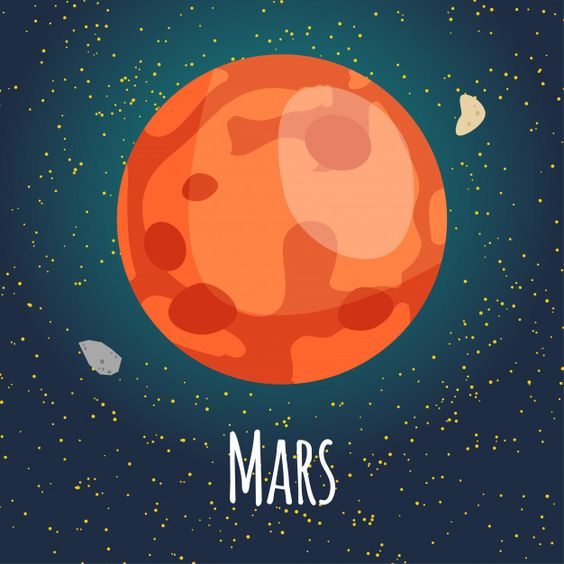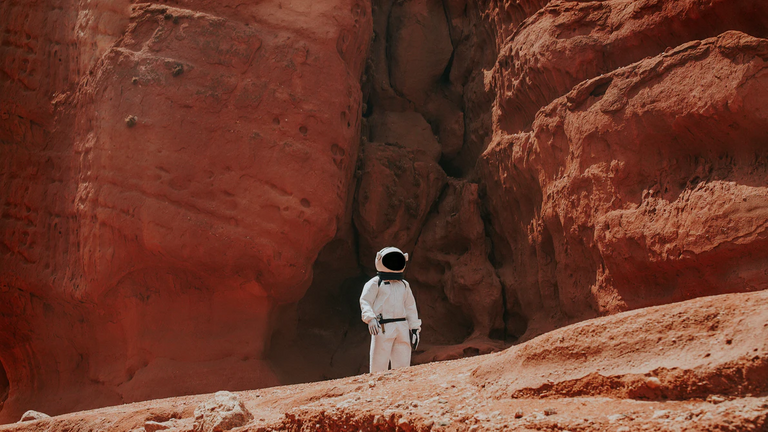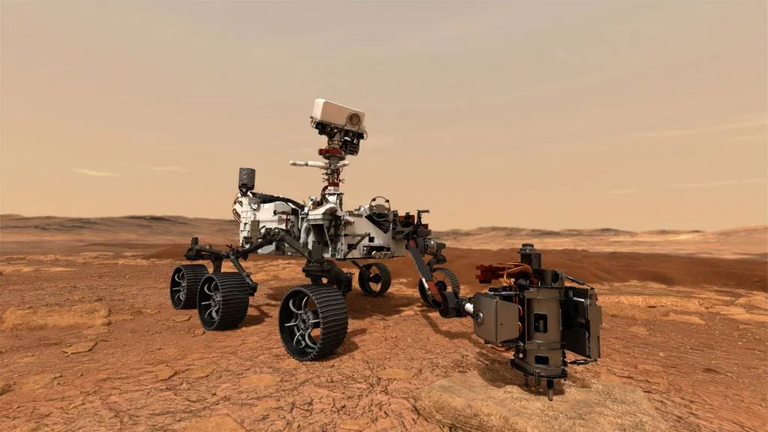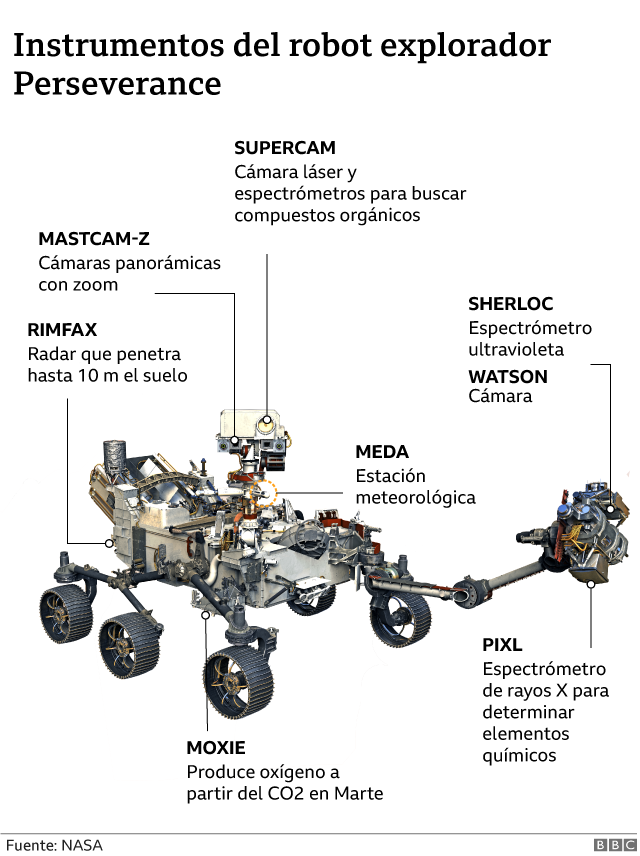Una nueva misión espacial llega a marte 👽| New space mission reaches 👽
Greetings Hivers! I hope you are very well, in my publication today I will talk about a topic that has been quite relevant in recent days, and it is about a new space mission that reached the planet Mars; although it is true that it is the fourth planet in our solar system in order of distance from the Sun, its reddish hue is due to the amount of iron oxide on its surface and this feature has earned it to be known as: "The Red Planet".

El resultado de misiones espaciales anteriores han determinado que Marte es un planeta desértico y frío, su tamaño es la mitad al de la Tierra. Marte al igual que la Tierra, tiene estaciones, casquetes polares, volcanes, cañones y clima, su atmósfera es poco densa; hecha de dióxido de carbono, nitrógeno y argón. Hay signos de antiguas inundaciones en Marte, pero ahora el agua existe principalmente en su polvo helado y sus nubes delgadas. En algunas laderas marcianas, se han encontrado pruebas de agua líquida salada.
The results of previous space missions have determined that Mars is a cold desert planet, half the size of Earth. Mars, like Earth, has seasons, polar ice caps, volcanoes, canyons and weather, its atmosphere is thin; made of carbon dioxide, nitrogen and argon. There are signs of ancient flooding on Mars, but now water exists mainly in its icy dust and thin clouds. On some Martian slopes, evidence of salty liquid water has been found.
Entre las características mas relevantes de Marte tenemos:
Estructura y superficie:
- Es un planeta terrestre, es pequeño y rocoso.
- Tiene una atmósfera poco densa.
- Cuenta con una atmósfera activa, pero la superficie del planeta no lo es. Los volcanes están inactivos.
El tiempo en Marte:
- Un día dura 24,6 horas, un poco más que un día en la Tierra.
- Un año equivale a 687 días en la Tierra, casi el doble que el año terrestre.
Vecinos de Marte:
- Tiene dos lunas: Fobos y Deimos.
- Es el cuarto planeta contando desde el Sol. Eso significa que la Tierra y Júpiter son sus vecinos.
Otros datos relevantes:
- Se conoce su existencia desde la antigüedad porque no es necesario usar los telescopios más avanzados para verlo.
- Varias misiones han visitado el planeta rojo, y es el único planeta por donde han circulado los rovers, que se han paseado por Marte tomando fotos y haciendo mediciones.Fuente
Among the most relevant features of Mars we have:
Structure and surface:
- A terrestrial planet, it is small and rocky.
- It has a thin atmosphere.
- It has an active atmosphere, but the surface of the planet is not active. The volcanoes are inactive.
Time on Mars:
- A day is 24.6 hours long, slightly longer than a day on Earth.
- A year is equivalent to 687 days on Earth, almost twice as long as the Earth year.
Neighbors of Mars:
- It has two moons: Phobos and Deimos.
- It is the fourth planet counting from the Sun. That means that Earth and Jupiter are its neighbors.
Other relevant data:
- Its existence has been known since antiquity because it is not necessary to use the most advanced telescopes to see it.
- Several missions have visited the red planet, and it is the only planet where rovers have circled, roving around Mars taking pictures and making measurements.Source

Mars 2020
Mars 2020 es una misión espacial del Programa de Exploración de Marte de la NASA, su lanzamiento fue realizado el 30 de julio de 2020, y aterrizó el pasado 18 de febrero de 2021 tras un viaje de aproximadamente 480 millones de km. Para llevar a cabo su misión planetaria, incluye un rover y un pequeño helicóptero: el helicóptero explorador Ingenuity, cuya función es planificar la mejor ruta para el desplazamiento del rover Perseverance.
Mars 2020 is a space mission of NASA's Mars Exploration Program, launched on July 30, 2020, and landed on February 18, 2021 after a journey of approximately 480 million km. To carry out its planetary mission, it includes a rover and a small helicopter: the Ingenuity explorer helicopter, whose function is to plan the best route for the Perseverance rover.

El Perseverance, es el rover explorador más sofisticado jamás enviado al espacio,con un peso de 1.043 kilos, tendrá como misión encontrar evidencia de vida microbiana antigua en el planeta rojo y describir su clima y geología, así como recolectar muestras de rocas y polvo para enviarlos más tarde a la Tierra con el fin de analizarlos y allanar el camino para la exploración humana en el futuro.
The Perseverance, the most sophisticated rover ever sent into space, weighing 1,043 kilograms, will be tasked with finding evidence of ancient microbial life on the red planet and describing its climate and geology, as well as collecting rock and dust samples to be sent back to Earth for analysis to pave the way for future human exploration.

El Perseverance cuenta con novedosos instrumentos, cerca de 20 cámaras, un helicóptero y hasta micrófonos. Sus instrumentos sofisticados pueden escanear el terreno y determinar su composición química,también tendrá una estación meteorológica donde medirá con sus sensores el viento, el polvo, la radiación ultravioleta y otros indicadores del clima en Marte. El Perseverance cuenta con un mecanismo que taladra y pulveriza la roca, y luego coloca esas muestras en tubos que guardará en su interior para luego dejarlos sobre la superficie donde en posteriores misiones serán traídos a la Tierra para su análisis.
The Perseverance is equipped with state-of-the-art instruments, about 20 cameras, a helicopter and even microphones. Its sophisticated instruments can scan the terrain and determine its chemical composition, and it will also have a weather station where its sensors will measure wind, dust, ultraviolet radiation and other indicators of Mars weather. The Perseverance has a mechanism that drills and pulverizes the rock, and then places these samples in tubes that will be stored inside and left on the surface where they will be brought back to Earth for analysis in later missions.

Por ultimo Hivers, es importante mencionar que no es la primera vez que se incursiona en Marte, entre los rovers utilizados en estas misiones tenemos: El Sojourner en 1997, Spirit y Opportunity, que aterrizaron en el planeta rojo en 2004; y el Curiosity, que ha explorado Marte desde 2012. Los científicos tanto de la NASA estadounidense como la ESO, de Europa, tienen como objetivo a través de estas misiones espaciales determinar si en Marte podría haber llegado a tener seres vivos en el pasado, así como también saber el potencial del planeta para poder albergar vida ahora o en el futuro...
Finally Hivers, it is important to mention that this is not the first time that Mars has been explored, among the rovers used in these missions we have: Sojourner in 1997, Spirit and Opportunity, which landed on the red planet in 2004; and Curiosity, which has explored Mars since 2012. Scientists from both NASA and ESO, from Europe, aim through these space missions to determine if Mars could have had living beings in the past, as well as to know the potential of the planet to host life now or in the future...
Hivers les comparto un vídeo del resumen del aterrizaje del Perseverance
Hivers I share with you a video of the Perseverance landing summary.
Sí te gusto, déjame tu opinión en los comentarios.
Traducciones realizadas a través de: DeepL
Translations made through:DeepL
Hello @victorh94
Certainly, Mars is one of the most striking forays for man, due to its similarity to our planet.
There are many projects aimed at the colonization of this planet, one of them is that of Elon Musk who recently saw his plans frustrated by the regulatory measures of the FAA Space Division, who claimed that the ban on SpaceX is for security.
Excellent read, thanks for sharing.
Best regards.
Congratulations @victorh94! You have completed the following achievement on the Hive blockchain and have been rewarded with new badge(s) :
Your next target is to reach 20 posts.
You can view your badges on your board and compare yourself to others in the Ranking
If you no longer want to receive notifications, reply to this comment with the word
STOPCheck out the last post from @hivebuzz: